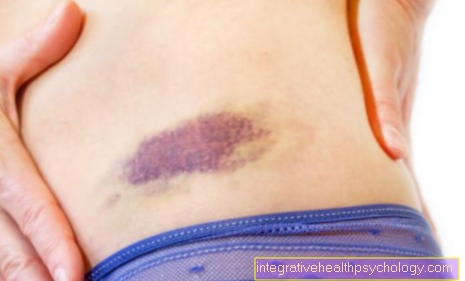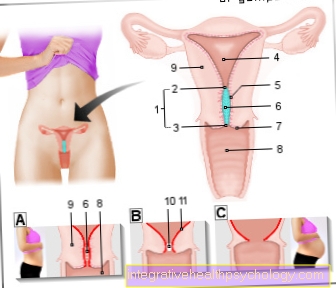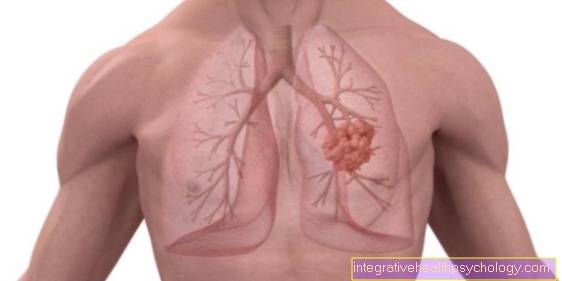Symptoms of a basalioma
introduction
The basalioma (Basal cell carcinoma, White skin cancer) is a malignant skin tumor that occurs primarily as a result of long-term exposure to UV radiation. As a result, most of the basaliomas are found on those areas of the skin that are frequently exposed to direct sunlight: 80% of basaliomas arise in the area of the head, face and neck, only about 5% are described on the trunk or extremities.
Basalioma is often referred to as semi-malignant: This is due to the fact that, unlike most other malignant tumors, it does not spread to other organs, i.e. no daughter tumors (Metastases) forms. Nevertheless, it can grow very aggressively locally and damage the tissue surrounding it. Various symptoms such as scaly patches, wound healing disorders and pain can develop.

The symptoms
Basaliomas are usually the same color as the surrounding skin and are therefore often not easy to recognize. However, in almost all subgroups of basalioma, a more or less pigmented basalioma can occur, which then appears brownish to black and is therefore often difficult to differentiate from malignant melanoma, the black skin cancer.
Apart from the typical appearance on the skin, the basalioma basically does not lead to any symptoms. However, if it is already at an advanced stage and has spread in depth, it can lead to complaints that can be explained by the damage to the surrounding structures. For example, a basalioma in the eye socket, especially if it is the aggressive form of the basalioma terebran, can result in loss of vision.
However, since basaliomas do not form metastases, secondary symptoms are always limited to the immediate vicinity of the tumor; organs located further away are not affected.
Find out all about the topic here: Basalioma.
The itching
Itching is a very unpleasant symptom of the skin and is felt exactly on the affected skin area with basalioma. The development of itching (pruritus) is not yet fully understood. An inflammatory reaction of the skin is suspected. Here, special tissue hormones such as histamine, serotonin or kinin are released, which act on the nerve endings of the skin and thus cause itching.
The itching, which is sometimes more pronounced and sometimes less pronounced, runs the risk of scratching the skin. After scratching, the wound bleeds and may ooze before it scabs again. The itching can be constant. However, since itching is not a key symptom of basalioma, it can be completely absent.
Also read the article: The inflammation.
The pain
Pain can also occur at the site of the basalioma. Mostly it is burning or sore pain. The burning sensation comes from the inflammation of the skin.
If the basalioma is scratched open, it can lead to a painful sore. Pain can arise especially when the wound is touched.
The bleeding
A basalioma can bleed again and again. Bleeding and crusting of the wound can alternate, especially over a longer period of time. Therefore, if you have a wound that has existed for more than three weeks and sometimes bleeds or wets and does not heal, you should always think of a basalioma and have it examined by a doctor.
Since the basalioma can also sometimes itch, a bleeding wound can also occur after scratching.
Find out more about the topic here: Prognosis of basalioma.
The redness
Basaliomas can look very different. On the one hand, there may be a reddish stain that crusts or flakes. The basalioma can also present itself as a red or light red lump.
Furthermore, there are more superficially visible vessels at the edge of the basalioma. These superficial vessels are also known as telangiectasias. These can also give the basalioma a reddish color. In addition, the skin around the basalioma can become inflamed, leading to reddening of the surrounding skin.
The crust
The incrustation of the surface of the basalioma is a typical symptom. Often oozing, bleeding and incrustation alternate. The place where the basalioma is located does not heal and the basalioma grows deeply in the course of the process, with a wound that is always superficially encrusted.
If the basalioma is scratched open due to itching, it can bleed and subsequently become encrusted.
Also read the article: The best therapy for a basalioma.
The scaling
The basalioma often presents itself as a scaly nodule. Under the initially skin-colored scales, the basalioma shows up as a poorly healing wound. Since basalioma is a skin tumor that destroys the skin, this scaling can occur. The top layer of the cornea is shed. Later on, reddish scales can develop.
White skin cancer? More information can be found here.
The skin changes
In general, a basalioma results in characteristic skin changes which, however, only become noticeable over a longer period of time, as this tumor usually grows rather slowly.
In the initial stage, where the basalioma later becomes visible, there is often simply a circumscribed induration of the skin or an initially inconspicuous, small, often grayish nodule. However, there are different types of basalioma, which can look very different.
More information on the subject Initial stage of basalioma you'll find here.





























